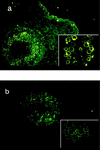Enterohemorrhagic Escherichia coli O157:H7 present in radish sprouts
- PMID: 9546189
- PMCID: PMC106182
- DOI: 10.1128/AEM.64.4.1532-1535.1998
Enterohemorrhagic Escherichia coli O157:H7 present in radish sprouts
Abstract
Using cultivation, immunofluorescence microscopy, and scanning electron microscopy, we demonstrated the presence of viable enterohemorrhagic Escherichia coli O157:H7 not only on the outer surfaces but also in the inner tissues and stomata of cotyledons of radish sprouts grown from seeds experimentally contaminated with the bacterium. HgCl2 treatment of the outer surface of the hypocotyl did not kill the contaminating bacteria, which emphasized the importance of either using seeds free from E. coli O157:H7 in the production of radish sprouts or heating the sprouts before they are eaten.
Figures


Similar articles
-
The effect of calcinated calcium and chlorine treatments on Escherichia coli O157:H7 87-23 population reduction in radish sprouts.J Food Sci. 2011 Aug;76(6):M404-12. doi: 10.1111/j.1750-3841.2011.02270.x. J Food Sci. 2011. PMID: 22417511
-
Combination treatments for killing Escherichia coli O157:H7 on alfalfa, radish, broccoli, and mung bean seeds.J Food Prot. 2009 Mar;72(3):631-6. doi: 10.4315/0362-028x-72.3.631. J Food Prot. 2009. PMID: 19343955
-
Inhibition of growth of Escherichia coli O157:H7 in fresh radish (Raphanus sativus L.) sprout production by calcinated calcium.J Food Prot. 1999 Feb;62(2):128-32. doi: 10.4315/0362-028x-62.2.128. J Food Prot. 1999. PMID: 10030630
-
Infections associated with eating seed sprouts: an international concern.Emerg Infect Dis. 1999 Sep-Oct;5(5):626-34. doi: 10.3201/eid0505.990503. Emerg Infect Dis. 1999. PMID: 10511518 Free PMC article. Review.
-
Use of Bacteriophages to Control Escherichia coli O157:H7 in Domestic Ruminants, Meat Products, and Fruits and Vegetables.Foodborne Pathog Dis. 2017 Sep;14(9):483-493. doi: 10.1089/fpd.2016.2266. Epub 2017 Jun 21. Foodborne Pathog Dis. 2017. PMID: 28636835 Review.
Cited by
-
Escherichia coli O157:H7 induces stronger plant immunity than Salmonella enterica Typhimurium SL1344.Phytopathology. 2013 Apr;103(4):326-32. doi: 10.1094/PHYTO-09-12-0230-FI. Phytopathology. 2013. PMID: 23301812 Free PMC article.
-
Multistate outbreak of Salmonella serovar Muenchen infections associated with alfalfa sprouts grown from seeds pretreated with calcium hypochlorite.J Clin Microbiol. 2001 Oct;39(10):3461-5. doi: 10.1128/JCM.39.10.3461-3465.2001. J Clin Microbiol. 2001. PMID: 11574556 Free PMC article.
-
Surface structures involved in plant stomata and leaf colonization by shiga-toxigenic Escherichia coli o157:h7.Front Microbiol. 2011 May 27;2:119. doi: 10.3389/fmicb.2011.00119. eCollection 2011. Front Microbiol. 2011. PMID: 21887151 Free PMC article.
-
Colonization of Arabidopsis thaliana with Salmonella enterica and enterohemorrhagic Escherichia coli O157:H7 and competition by Enterobacter asburiae.Appl Environ Microbiol. 2003 Aug;69(8):4915-26. doi: 10.1128/AEM.69.8.4915-4926.2003. Appl Environ Microbiol. 2003. PMID: 12902287 Free PMC article.
-
Nickel exposure reduces enterobactin production in Escherichia coli.Microbiologyopen. 2019 Apr;8(4):e00691. doi: 10.1002/mbo3.691. Epub 2018 Jul 30. Microbiologyopen. 2019. PMID: 30062714 Free PMC article.
References
-
- Andrews W H, Mislivec P B, Wilson C R, Bruce V R, Poelma P L, Gibson R, Trucksess M W, Young K. Microbial hazards associated with bean sprouting. J Assoc Off Anal Chem. 1982;65:241–248. - PubMed
-
- Beuchat L R. Comparison of chemical treatment to kill salmonella on alfalfa seeds destined for sprout production. Int J Food Microbiol. 1997;34:329–333. - PubMed
-
- Como-Sabetti K, Reagan S, Allaire S, Parrott K, Simonds C M, Hrabowy S, Ritter B, Hall W, Altamirano J, Martin R, Downes F, Jennings G, Barrie R, Dorman M F, Keon N, Kucab M, Al Shab A, Robinson-Dunn B, Dietrich S, Moshur L, Reese L, Smith J, Wilcox K, Tilden J, Wojtala G, Park J D, Winnett M, Petrilack L, Vasquez L, Jenkins S, Barrett E, Linn M, Woolard D, Hackler R, Martin H, McWilliams D, Rouse B, Willis S, Rullan J, Miller G, Jr, Henderson S, Pearson J, Beers J, Davis R, Saunders D Food-Borne and Diarrheal Diseases Branch, Division of Bacterial and Mycotic Diseases, National Center for Infectious Diseases, Centers for Disease Control and Prevention. Outbreaks of Escherichia coli O157:H7 infection associated with eating alfalfa sprouts—Michigan and Virginia, June-July 1997. Morbid Mortal Weekly Rep. 1997;46:741–744.
-
- Hara-Kudo Y, Konuma H, Iwaki M, Kasuga F, Sugita-Konishi Y, Ito Y, Kumagai S. Potential hazard of radish sprouts as a vehicle of Escherichia coli O157:H7. J Food Prot. 1997;60:1125–1127. - PubMed
MeSH terms
Substances
LinkOut - more resources
Full Text Sources

